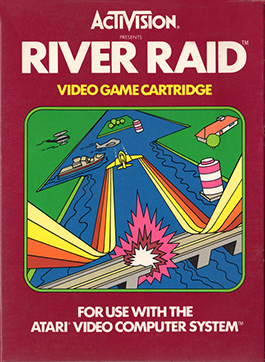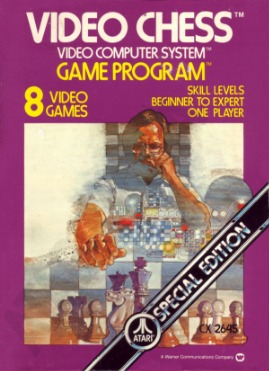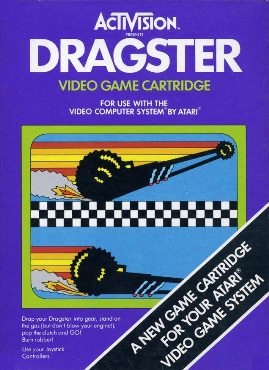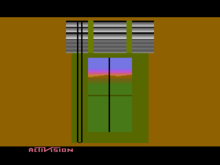
The Atari 2600 is a discontinued home video game console developed and produced by Atari, Inc. Released in September 1977 as the Atari Video Computer System, it popularized microprocessor-based hardware and games stored on swappable ROM cartridges, a format first used with the Fairchild Channel F in 1976. The VCS was bundled with two joystick controllers, a conjoined pair of paddle controllers, and a game cartridge—initially Combat and later Pac-Man. Sears sold the system as the Tele-Games Video Arcade. Atari rebranded the VCS as the Atari 2600 in November 1982 alongside the release of the Atari 5200.

The Atari 7800 ProSystem, or simply the Atari 7800, is a home video game console officially released by Atari Corporation in 1986 as the successor to both the Atari 2600 and Atari 5200. It can run almost all Atari 2600 cartridges, making it one of the first consoles with backward compatibility. It shipped with a different model of joystick from the 2600-standard CX40 and Pole Position II as the pack-in game. Most of the announced titles at launch were ports of 1981–1983 arcade video games.

Activision Publishing, Inc. is an American video game publisher based in Santa Monica, California. It serves as the publishing business for its parent company, Activision Blizzard, and consists of several subsidiary studios. Activision is one of the largest third-party video game publishers in the world and was the top United States publisher in 2016.
Alan Miller is an American video game designer who was the co-founder of the video game company Activision.

Adventure is a video game developed by Warren Robinett for the Atari Video Computer System and released in 1980 by Atari, Inc. The player controls a square avatar whose quest is to explore an open-ended environment to find a magical chalice and return it to the golden castle. The game world is populated by roaming enemies: three dragons that can eat the avatar and a bat that randomly steals and moves items around the game world. Adventure introduced new elements to console games, including enemies that continue to move when offscreen.

Pitfall! is a video game developed by David Crane for the Atari 2600 and released in 1982 by Activision. The player controls Pitfall Harry, who has a time limit of 20 minutes to seek treasure in a jungle. The game world is populated by enemies and hazards that variously cause the player to lose lives or points.

David Crane is an American video game designer and programmer. Crane grew up fascinated by technology and went to DeVry Institute of Technology. Following college, he went to Silicon Valley and got his first job at National Semiconductor. Through his friend Alan Miller he learned about potential video game design work at Atari, Inc. and began work there in 1977.

River Raid is a video game developed by Carol Shaw for the Atari Video Computer System and released in 1982 by Activision. The player controls a fighter jet over the River of No Return in a raid behind enemy lines. The goal is to navigate the flight by destroying enemy tankers, helicopters, fuel depots and bridges without running out of fuel or crashing.

Pitfall II: Lost Caverns is a video game developed by David Crane for the Atari 2600. It was released in 1984 by Activision. The player controls Pitfall Harry, who must explore in wilds of Peru to find the Raj Diamond, and rescue his niece Rhonda and their animal friend Quickclaw. The game world is populated by enemies and hazards that variously cause the player to lose points and return to a checkpoint.

The Atari Flashback series is a line of dedicated video game consoles designed, produced, published and marketed by AtGames under license from Atari SA. The Flashback consoles are "plug-and-play" versions of the Atari 2600 console. They contain built-in games rather than using the ROM cartridges utilized by the 2600. Most of the games are classics that were previously released for the 2600, although some Flashback consoles include previously unreleased prototype games as well.

Grand Prix is a Formula One Grand Prix motor racing-themed video game. It was designed and programmed by David Crane for the Atari 2600 and published by Activision in 1982.

Boxing is a video game interpretation of the sport of boxing developed by programmer Bob Whitehead for the Atari VCS. It was published by Activision in 1980. It's one of the first video games developed by Activision. The game is based on Boxer, an unreleased 1978 arcade game from Whitehead's previous employer, Atari, Inc. Boxer was written by Mike Albaugh who also wrote Drag Race for Atari, a game cloned by Activision as Dragster.
Robert A. Whitehead is an American video game designer and programmer. While working for Atari, Inc. he wrote two of the nine Atari Video Computer System launch titles: Blackjack and Star Ship. After leaving Atari, he cofounded third party video game developer Activision, then Accolade. He left the video game industry in the mid-1980s.

Activision Anthology is a compilation of most of the Atari 2600 games by Activision for various game systems. It also includes games that were originally released by Absolute Entertainment and Imagic, as well as various homebrew games. The Microsoft Windows and Mac OS X versions are titled Activision Anthology: Remix Edition, and include the most games. The PlayStation Portable version is titled Activision Hits Remixed.

Save Mary is a prototype video game designed by Tod Frye and made for the Atari 2600. The game involves Mary who is trapped in a valley that is slowly filling with water. The player must operate a crane to move blocks to allow Mary to escape the rising water and eventually be carried to safety by the player.

Carol Shaw is one of the first female game designers and programmers in the video game industry. She is best known for creating the Atari 2600 vertically scrolling shooter game River Raid (1982) for Activision. She worked for Atari, Inc. from 1978 to 1980, where she designed multiple games including 3-D Tic-Tac-Toe (1978) and Video Checkers (1980), both for the Atari VCS before it was renamed to the 2600. She left game development in 1984 and retired in 1990.

Video Chess is a chess game for the Atari VCS programmed by Larry Wagner and Bob Whitehead and released by Atari in 1979. Both programmers later developed games for Activision.

Dragster, released in 1980 for the Atari Video Computer System, is one of the first video games developed by Activision.

Absolute Entertainment was an American video game publishing company. Through its development house, Imagineering, Absolute Entertainment produced titles for the Atari 2600, Atari 7800, Game Gear, Genesis/Mega Drive, Sega CD, Game Boy, Nintendo Entertainment System, and Super Nintendo Entertainment System video game consoles, as well as for the Commodore 64, Apple II, and IBM PC compatibles.

Video Checkers is a video game developed and published by Atari, Inc. in 1980 for the Atari VCS, renamed to Atari 2600.




















